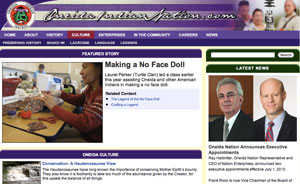talking history | syllabi | students | teachers | puzzle | about us
Oneida Indian Nation: Culture and History
http://www.oneidaindiannation.com/culture/
Created and maintained by the Oneida Indian Nation, Oneida, N.Y.
Reviewed July 5–14, 2005.
Oneida Indian Nation: Culture and History is one part of the official Web site of the Oneida Indian Nation, a federally recognized tribe in central New York that operates the Turning Stone Casino Resort. The Web site as a whole includes information on and news about Oneida economic development, employment opportunities, and government programs and services. As its name indicates, the “Culture and History” page of the site contains resources relating to Oneida customs and traditions and to key events and figures of the Oneida past.

One of the more interesting parts of the “Culture” section of the site is a link to the Oneida Nation’s Shako:wi Culture Center. Here one can take a virtual tour of the center and find links to exhibits on basketry, beadwork, and wampum and stories, artifacts, and artwork related to Oskanondohna, a late eighteenth-century Oneida leader. This area of the site also includes basic information on the clans and important symbols of the Oneida and the Iroquois Confederacy; texts of the Iroquois creation story and a number of Iroquois legends; a discussion of the tradition of lacrosse; and a “Three Sisters Cookbook,” which includes recipes using corn, beans, and squash. There is also a link to samples of the Oneida language from the Oneida Language Project, but there is little information about the project itself. Another area of the site links to oral history excerpts collected from Oneida elders on such topics as corn, crafts, language, annuity cloth, herbal medicine, and land claims.
The “History” section of the site focuses on the late eighteenth- and early nineteenth-century history of the Oneidas and highlights their role as allies to the emerging United States during the American Revolution and the War of 1812. Included are stories about the battles at Oriskany and Barren Hill and a story and short video about Polly Cooper, who is said to have played a notable role in aiding George Washington and his troops. Also included is a link to the Oneida Nation Treaties Project, where one can find the texts of treaties and related documents important to Oneida land and sovereignty claims. A related part of the site summarizes the history of the Oneidas' effort to reclaim their land and sovereignty.
The “Culture and History” site is well organized and easy to navigate, though its main page could be better utilized. For instance, examples of the artwork, illustrations, and photographs found in specific content areas could be used to make the site more attractive to visitors and provide a better idea of the resources to be found on the site. In some instances, such as with the Shako:wi Culture Center links, the site makes effective use of new media, but the resources on the site are largely textual.
Presented from the perspective of the Oneida Nation, the site is oriented toward those with a general interest in Oneida history and culture, and it will be helpful to primary and secondary school teachers, who should find its information and graphic resources useful for teaching about the Oneida and the Iroquois. The site will be of limited interest to a more scholarly audience. There is little new scholarship to be found here, and, with a few exceptions, the textual, audio, and visual resources do not include sources or bibliographies.
Gerald F. Reid
Sacred Heart University
Fairfield, Connecticut
